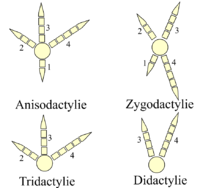Bird feet

Bird feet are adapted to the life they lead, and the patterns are often use in avian classification. They are derived from the basic limb of ancestral tetrapods, the pentadactyl limb. Humans (and other primates) have the original five fingers and five toes. Birds have no more than four toes, inherited together with over a hundred anatomical features from theropod dinosaurs.[1] These four toes are arranged into four main patterns.[2]
Arrangement of toes
- Anisodactyly. This is the most common arrangement of toes in birds, with three toes forward and one back. It is the basic pattern in passerine birds, especially the songbirds, and hunting birds like eagles, hawks, and falcons.
The anisodactyl arrangement lets passerine birds perch on vertical surfaces, such as trees and cliffs. The hind toe joins the leg at the same level as the front toes.
The leg arrangement of passerine birds has a special adaption for perching: a tendon-locking mechanism. A tendon in the rear of the leg is automatically pulled and tightened when the leg bends. This makes the foot curl stiffly round when the when the bird lands on a branch. The tendon is locked in place by another tendon. So passerines sleep while perching without falling off.[3][4]
Certain species of passerines have stiff tail feathers, which help the birds balance themselves when perching on vertical surfaces.
Syndactyly is like anisodactyly, except that the third and fourth toes or three toes, are fused together. This is characteristic of Coraciiformes (kingfishers, bee-eaters, rollers, and relatives). - Zygodactyly. This has two toes facing forward (digits 2 and 3) and two back (digits 1 and 4). This arrangement is most common in arboreal species, particularly those that climb tree trunks or clamber through foliage. Zygodactyly occurs in the parrots, woodpeckers (including flickers), cuckoos (including roadrunners), and some owls. Zygodactyl tracks have been found dating to 120–110 million years ago (Lower Cretaceous), 50 million years before the first identified zygodactyl fossils.[5]
- Heterodactyly. Heterodactyly is like zygodactyly, except that digits 3 and 4 point forward and digits 1 and 2 point back. This is found only in trogons.
- Pamprodactyly is an arrangement where all four toes may point forward, or birds may rotate the outer two toes backward. It is a characteristic of swifts (Apodidae).
- Didactyly. The ostrich has just two toes on each foot, with the nail on the larger, inner toe resembling a hoof. The outer toe has no nail. The reduced number of toes is an adaptation to its life on open land. Ostriches can run at a speed over 70 km/h (43 mph) and can cover 3 to 5 m (9.8 to 16.4 ft) in a single stride.[6]
Parts of the leg
Knee joint
The bird knee joint between the femur and tibia (or rather tibiotarsus) points forwards, but is hidden in the feathers. The backward-pointing "heel" (ankle) that is easily visible is a joint between the tibiotarsus and the tarsometatarsus.
Tarsometatarsus
The tarsometatarsus is the third segment of the leg. Only birds have this. It evolved from bones of the ankle in their ancestors. The tarsometatarsus is the extended foot area, which gives the leg extra lever length.[7]
Scales
The scales of birds are made of the same keratin as beaks, claws, and spurs. They are found on the toes and sometimes further up on the ankle. The scales and scutes of birds are thought to be homologous with those of reptiles, and feathers have developed from the scales of Archosaurs.[8]
Bird Feet Media
African jacana. Extremely long toes and claws help distribute the jacana's weight over a wide area to allow it to walk on floating leaves.
Chick of Pelargopsis capensis with heel-pads
The ostrich is the only bird that has the didactyl foot.
Grey parrot grips the perch with zygodactyl feet.
Palmate feet – Chilean flamingo.
Totipalmate feet – blue-footed booby.
Western grebe presenting a lobate foot.
Lobate feet – a chick of the Eurasian coot.
The great crested grebe. The feet in loons and grebes are placed far at the rear of the body - a powerful accommodation to swimming underwater, but a handicap for walking.
References
- ↑ Mayr, Gerald 2016. Avian evolution. Wiley. doi:10.1002/9781119020677. ISBN 9781119020677.
- ↑ Proctor N.S. & Lynch P.J. 1998. Manual of Ornithology: avian structure & function. Yale University Press. ISBN 0300076193
- ↑ Stefoff, Rebecca 2008. The bird class. Marshall Cavendish Benchmark.
- ↑ Brooke, Michael and Tim Birkhead 1991. The Cambridge Encyclopedia of Ornitholigy. Cambridge University Press.
- ↑ "Earliest zygodactyl bird feet: evidence from Early Cretaceous roadrunner-like tracks". Naturwissenschaften. 2007.[dead link]
- ↑ San Diego Zoo's Animal Bytes: Ostrich. Sandiegozoo.org. Retrieved on 2012-08-21.
- ↑ Proctor, Noble S. & Lynch, Patrick J. 1993. Chapters: 6. Topography of the foot; 11. The pelvic girdle, and 12. The bones of the leg and foot family. Manual of Ornithology: avian structure & function. New Haven and London: Yale University Press. pp. 70–75, 140–141, 142–144. ISBN 978-0-300-07619-6
- ↑ Feduccia, Alan 1999. The origin and evolution of birds. 2nd ed, Yale University Press, p132/3 The first feathers as aerodynamic structures.
